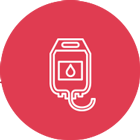
End of Life Care and Pain Management
End Of Life And Pain Management For Pets
When is it time to say goodbye?
Life expectancy has increased dramatically over the last century for humans and for our animal companions. In 1930 the average life span for dogs was 7 years, today it is 12 years. Aging not only occurs at different rates for humans and their pets, it may also differ among members of the same species of pet. For example, the most familiar calculation for a dog’s lifespan is to multiply the pet’s age by a factor of 7 to get the human equivalent. But because larger breeds usually “age” faster than smaller ones,a more detailed guide based on body weight is used to determine their human equivalent age.
Many of the hospice and palliative careprinciples that have been successfully adopted in human hospice for decades arenow being embraced to provide end of life care for terminal pets and theirfamilies by veterinary professionals. The term palliative care is frequentlyused when discussing end of life care. The word “palliative” means to abate orreduce the intensity.
The emergence of veterinary end of life and palliative care is a comprehensive healthcare option to provide dignity and choice to terminal pets and their families.
How do you know when it’s time to say goodbye?
Pet Care givers can use this Quality of Life Scale to determine if your pet has acceptable life quality (need a total over 35 points for acceptable quality of life).
- HURT-Adequate pain control and breathing ability is the top concern. Is oxygen supplementation necessary? Score 0-10.
- HUNGER-Is the pet eating enough. Does he/she need a feeding tube? Score 0-10
- HYDRATION– Is your pet dehydrated? We can teach you to give fluids under your pet’s skin at home 1-2 times daily. Score 0-10
- HYGIENE– Your pet must be brushed and cleaned especially after eliminations. Avoid Pressure sores with soft bedding. Score 0-10
- HAPPINESS– Does your pet express joy and interest? Is your pet depressed, anxious or afraid? Try moving the pet bed closer to family activities. Score 0-10
- MOBILITY– Can your pet get up with assistance? Is the pet having seizures or stumbling? A pet with limited mobility can still be alert, happy and responsive. Score 0-10
- MORE GOOD DAYS THAN BAD– When bad days out number good days, a healthy human animal bond may not be possible. If your pet is suffering, a euthanasia decision may be the best decision so the end is peaceful and painless. Score 0-10
Download the Quality Of Life Scale here.
Veterinary medical conditions that benefit from Special care
Not surprisingly, cancer is the most common condition seen in end of life care. Renal failure, Cardiac failure and Central Nervous System conditions such as brain tumors and spinal cord tumors may also be good candidates for end of life care. End of Life care may provide benefit to the family and pet by providing supportive home care to afford them the time to make further decisions regarding euthanasia or management are certainly to be considered in this type of care. As veterinarians, we find that pet owners are more concerned about their pet’s pain level than any other sign of disease. We can offer many forms of pain control including oral and injectable narcotics, patches, and changes in home environment to make your pet more comfortable.
The Human – Animal Bond
By the AVMA definition, the human animal bond is a mutually beneficial and dynamic relationship between people and their pets. As veterinarians, our role in the human animal bond is to maximize the potentials of this relationship between people and animals. End of Life Care means redefining hope to include a kinder, gentler death with more good days than bad toward the end of time here on earth and hope that the days before death can be filled with rich and memorable experiences guided and assisted by a caring team of end of life professionals.





